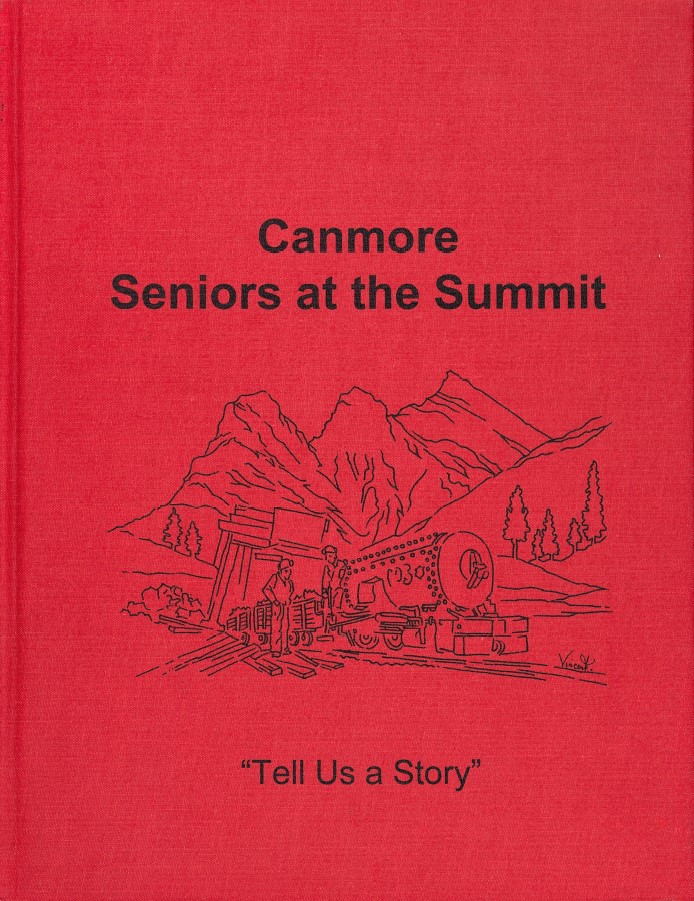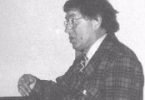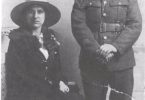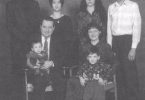John Meili first came to Canmore about 1923, coming here from Edson. He was a steam engineer for a locomotive. When he came to Canmore he worked in the powerhouse. After assessing the situation, a company house was available with rent of $4 a month. Pay was $8 a week so he returned to Switzerland, proposed to my mother, then my mother came to Canada and worked on a farm until she married my dad. They had four children: three sons, Robert, John, and Eric, and one daughter, Bertha.
All went to school in Canmore on the site of Lawrence Grassi School. We walked home for lunch – about a mile. In those days married women didn’t work so we had a stay-at-home mom. We had a Christmas concert. Thanks to the mine company, everyone received candy, an orange and one toy from Santa at the concert which was school involved. We always had church picnics at Duthill which is near the park gates, just to the left on a flat area. We had sack races. The location of the park gates has changed through the years.
Through the church, I, Bert, went to summer school at Bowfort, now called Nakoda. I remember motorboating on the lake. It seems as if it were a lot bigger then. The leaders taught us sewing, needlecraft, hiking, botany, etc. a good two weeks out of every summer. A man, by the last name of Young, took us to the camp for years and years.
For winter entertainment, we had the best hill in town for sliding on cardboard. We went skiing behind where the Nordic Centre is now (Backward L). The mine had the arena, so we were able to skate and play hockey. There were concerts at the Union Hall every winter and then, of course, we went to church a lot more too. My father owned a Ford car and we occasionally drove to Banff on Sunday afternoon. Church picnics were also held at Lake Minnewanka.
My father passed away before he was able to enjoy total retirement but he really expected Canmore to flourish. Mom carried on and lived until she was eighty-nine. Home help at that time was a blessing to help older people remain in their homes.
John is in Calgary. His children are Diane, Dale and Debbie. Diane lived in the Peace River country and published a book called, “Those Who Know”. Robert, (a retired mechanic with the city), is in Lethbridge. His children are Edward and Valerie. Eric remained here, married, and had three children: Judy, Wayne and Blaine. I, Bert, was able to go spend a year in Europe in 1952. We went by boat; this was the year of the Coronation. I spent the year doing casual work.
Because my parents were born in Switzerland, I had the opportunity for several jobs. Because the girl, Alice, who accompanied me was not in the same situation, we were limited to casual work. We lived in London, in East Ham, worked at Plessey’s where they manufactured TV’s. This was when television first came out. We were there for the coronation celebrations and had to be in our seats by five in the morning but it was worth it. We stayed with relatives in Switzerland and Scotland and the fare was only about $300. We also attended ceremonies for two royal burials.
I married Matthew Clark, who was born in Scotland, came to Saskatchewan when he was two, trained to be an electrician, and eventually worked at Canada Cement. We lived in Canmore. We were able to travel a fair amount, to Vienna and Rome, to Mexico, all of California, northern Alberta, northern Saskatchewan and Manitoba at fishing camps. Matt went to school in Montreal so we visited there for a couple of weeks and had the good fortune to really see that city. That is also the time I saw Ottawa, really a beautiful place.
Matt passed away in January, 1994. The family endured twelve deaths that year. Matt’s nephew and his girlfriend came to live with me for a year while they were attending university in Calgary. They were wonderful kids.
To keep busy since then, I look after my yard, hike when I can. I have been lucky to go on a cruise, have travelled to Europe and visited Vegas and Phoenix.
In Canmore Seniors at the Summit, ed. Canmore Seniors Association, 2000, p. 208-209.








